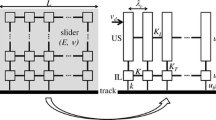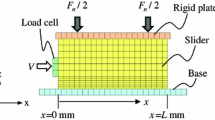Abstract
The dynamic initiation of sliding at planar interfaces between deformable and rigid solids is studied with particular focus on the speed of the slip front. Recent experimental results showed a close relation between this speed and the local ratio of shear to normal stress measured before slip occurs (static stress ratio). Using a two-dimensional finite element model, we demonstrate, however, that fronts propagating in different directions do not have the same dynamics under similar stress conditions. A lack of correlation is also observed between accelerating and decelerating slip fronts. These effects cannot be entirely associated with static local stresses but call for a dynamic description. Considering a dynamic stress ratio (measured in front of the slip tip) instead of a static one reduces the above-mentioned inconsistencies. However, the effects of the direction and acceleration are still present. To overcome this, we propose an energetic criterion that uniquely associates, independently on the direction of propagation and its acceleration, the slip front velocity with the relative rise of the energy density at the slip tip.






Similar content being viewed by others
Reference
Blau, P.J.: Friction Science and Technology, 2nd edn. CRC Press, Boca Raton (2009)
Xia, K., Rosakis, A.J., Kanamori, H.: Laboratory earthquakes: the sub-Rayleigh-to-supershear rupture transition. Science 303, 1859–1861 (2004)
Coker, D., Lykotrafitis, G., Needleman, A., Rosakis, A.J.: Frictional sliding modes along an interface between identical elastic plates subject to shear impact loading. J. Mech. Phys. Solids 53, 884–922 (2005)
Heaton, T.H.: Evidence for and implications of self-healing pulses of slip in earthquake rupture. Phys. Earth Planet. Inter. 64, 1–20 (1990)
Ben-Zion, Y.: Dynamic ruptures in recent models of earthquake faults. J. Mech. Phys. Solids 49, 2209 (2001)
Scholz, C.H.: The Mechanics of Earthquakes and Faulting, 2nd edn. Cambridge University Press, Cambridge (2002)
Rubinstein, S.M., Cohen, G., Fineberg, J.: Detachment fronts and the onset of dynamic friction. Nature 430, 1005–1009 (2004)
Rubinstein, S., Cohen, G., Fineberg, J.: Dynamics of precursors to frictional sliding. Phys. Rev. Lett. 98, 226103 (2007)
Baumberger, T., Caroli, C., Ronsin, O.: Self-healing slip pulses along a gel/glass interface. Phys. Rev. Lett. 88, 075509 (2002)
Ben-David, O., Cohen, G., Fineberg, J.: The dynamics of the onset of frictional slip. Science 330, 211 (2010)
Braun, O., Barel, I., Urbakh, M.: Dynamics of transition from static to kinetic friction. Phys. Rev. Lett. 103, 194301 (2009)
Maegawa, S., Suzuki, A., Nakano, K.: Precursors of global slip in a longitudinal line contact under non-uniform normal loading. Tribol. Lett. 38, 313 (2010)
Bouchbinder, E., Brener, E., Barel, I., Urbakh, M.: Slow cracklike dynamics at the onset of frictional sliding. Phys. Rev. Lett. 107, 235501 (2011)
Trømborg, J., Scheibert, J., Amundsen, D., Thøgersen, K., Malthe-Sørenssen, A.: Transition from static to kinetic friction: insights from a 2D model. Phys. Rev. Lett. 107, 074301 (2011)
Amundsen, D.S., Scheibert, J., Thøgersen, K., Trømborg, J., Malthe-Sørenssen, A.: 1D model of precursors to frictional stick–slip motion allowing for robust comparison with experiments. Tribol. Lett. 45, 357 (2012)
Di Bartolomeo, M., Meziane, A., Massi, F., Baillet, L., Fregolent, A.: Dynamic rupture at a frictional interface between dissimilar materials with asperities. Tribol. Int. 43, 1620 (2010)
Belytschko, T., Liu, W.K., Moran, B.: Nonlinear Finite Elements for Continua and Structures. Wiley, Chichester (2000)
Rayleigh, J.W.S.: The Theory of Sound, vol. 1, 2nd edn. Dover Publications, New York (1945)
Caughey, T.K.: Classical normal modes in damped linear dynamic systems. J. Appl. Mech. 27, 269–271 (1960)
Ben-David, O., Fineberg, J.: Static friction coefficient is not a material constant. Phys. Rev. Lett. 106, 254301 (2011)
Scheibert, J., Dysthe, D.K.: Role of friction-induced torque in stick–motion. Europhys. Lett. 92, 54001 (2010)
Coker, D., Rosakis, A.J., Needleman, A.: Dynamic crack growth along a polymer composite–Homalite interface. J. Mech. Phys. Solids 51, 425–460 (2003)
Acknowledgments
The authors are grateful to D. Coker for fruitful discussions and N. Richart for helpful advices on the simulations. The research described in this article is supported by the European Research Council (ERCstg UFO-240332).
Author information
Authors and Affiliations
Corresponding author
Rights and permissions
About this article
Cite this article
Kammer, D.S., Yastrebov, V.A., Spijker, P. et al. On the Propagation of Slip Fronts at Frictional Interfaces. Tribol Lett 48, 27–32 (2012). https://doi.org/10.1007/s11249-012-9920-0
Received:
Accepted:
Published:
Issue Date:
DOI: https://doi.org/10.1007/s11249-012-9920-0




